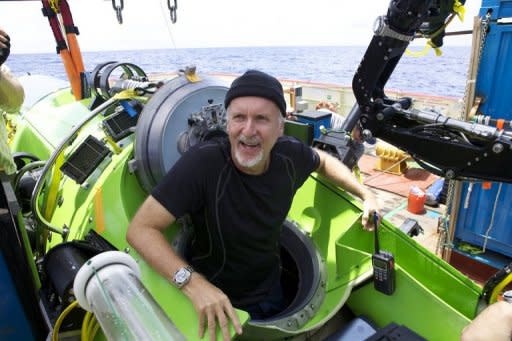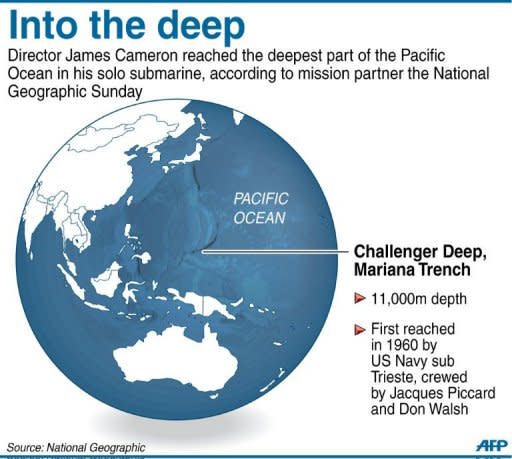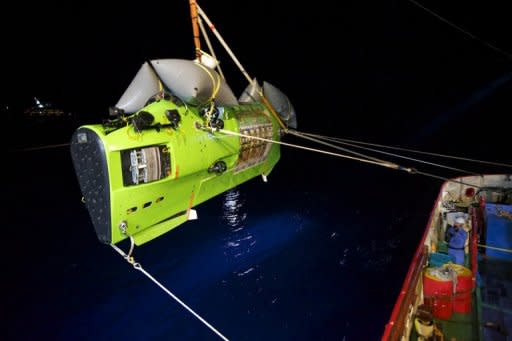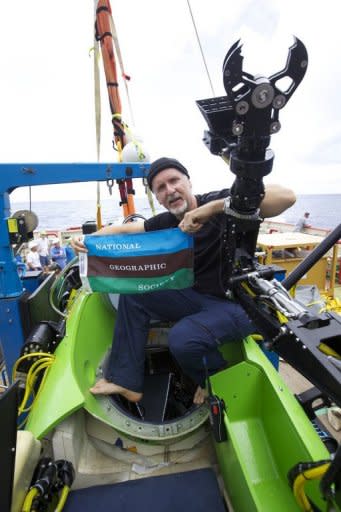'Titanic' director dives to Earth's deepest point
"Titanic" director James Cameron returned to the surface Monday after a solo submarine dive to the deepest point in the world's oceans that was hailed as the ultimate test of "man and his machine". Cameron plunged about seven miles (11 kilometers) to the bottom of the Mariana Trench in the western Pacific, where temperatures are barely above freezing and the pressure is a crushing thousand times that at sea level. Speaking after the mission, the filmmaker-explorer described a barren "completely alien world" on the ocean floor, not unlike the surface of the moon. It was a "very lunar, very desolate place. Very isolated," Cameron said. "I felt like I, in the space of one day, had gone to another planet and come back," he said, describing the ocean floor as a "completely featureless, alien world." The acclaimed film director described the experience of hurtling down the "yawning chasm" of the ocean: "Falling through darkness -- that's something that a robot can't describe." The voyage was the first manned expedition to the trench in more than half a century and Cameron said it was the culmination of more than seven years of planning. "Most importantly, though, is the significance of pushing the boundaries of where humans can go, what they can see and how they can interpret it," he said in a statement. The journey down to the Challenger Deep valley of the Mariana Trench, which lies southwest of Guam, took two hours and 36 minutes, organizers said. He told reporters in a phone press conference that he was at the bottom of the ocean for about a little more than two and a half hours, and had to cut short the planned stay of six hours because of problems with the ocean craft's hydraulics system. Cameron said that being able to make the journey was "the culmination from my perspective of a lifelong dream," and that he hopes to be able to continue to marry his love of exploring the depths of the sea with his work as a director. He collected samples for research in marine biology, microbiology, astrobiology, marine geology and geophysics, and captured photographs and 3D moving images. Cameron is the first person to make a solo dive to the Pacific Ocean trench. The last dive of any kind there was made by a two-man team in a relatively brief expedition back in 1960. After a faster-than-expected, roughly 70-minute ascent, Cameron's sub, bobbing in the open ocean, was spotted by helicopter and plucked from the Pacific by a research ship's crane, organizers said. Expedition physician Joe MacInnis called Cameron's descent "the ultimate test of a man and his machine." Mission partner the National Geographic said Cameron had reached a depth of 35,756 feet (10,898 meters) at 7:52 am Monday (2152 GMT Sunday) in his specially designed submersible the Deepsea Challenger. Because of its extreme depth, the Mariana Trench is cloaked in perpetual darkness and the temperature is just a few degrees above freezing. The water pressure at the bottom is a crushing eight tons per square inch -- or about a thousand times the standard atmospheric pressure at sea level. The images collected by Cameron will be used to make a 3-D feature film, which is expected to be broadcast on the National Geographic Channel. Cameron's tools included a sediment sampler, a robotic claw, a "slurp gun" for sucking up small sea creatures for study at the surface, and temperature, salinity, and pressure gauges. The submersible that Cameron designed -- a "vertical torpedo" of sorts -- had already successfully completed an unpiloted dive on Friday. In 1960, a two-man crew aboard the US Navy submersible Trieste -- then the only humans to have reached Challenger Deep -- spent just 20 minutes on the bottom, but their view was obscured by silt stirred up when they landed. Cameron, 57, had been running several miles a day, practicing yoga to increase his flexibility for the dive in the sub's cramped quarters and studying deep-ocean science. Cameron already has 72 dives under his belt, including 12 to film the blockbuster "Titanic." The Mariana Trench, a crescent-shaped scar in the Earth's crust, measures more than 1,500 miles (2,550 kilometers) long and 43 miles (69 kilometers) wide on average.





